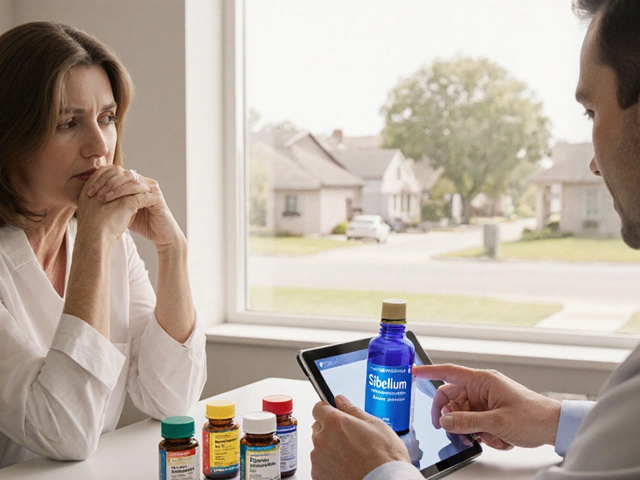28
Flunarizine (Sibelium) vs. Top Alternatives for Migraine and Vertigo

Migraine Preventive Medication Selector
Select Your Symptoms and Preferences
When doctors and patients start looking for a long‑term solution to migraine or recurring vertigo, the name flunarizine often pops up. Sold as Sibelium in many markets, the drug belongs to a niche class of calcium‑channel blockers that double as antihistamines. But it isn’t the only option on the shelf, and choosing the right preventive medication can feel like navigating a maze of side‑effects, dosing schedules, and insurance formularies.
Key Takeaways
- Flunarizine is effective for migraine and vestibular disorders but may cause weight gain and sedation.
- Top alternatives include topiramate, propranolol, amitriptyline, venlafaxine, and CGRP monoclonal antibodies.
- Decision factors are indication, side‑effect profile, drug interactions, and patient lifestyle.
- Most alternatives are inexpensive generics, while newer CGRP antibodies are pricey but have fewer systemic effects.
- Consult your clinician to match the drug’s pharmacology with your specific symptoms.
What Is Flunarizine?
Flunarizine is a lipophilic calcium‑channel blocker that also has antihistaminic activity. First launched in the 1980s, it entered the market under the brand name Sibelium in Europe and parts of Asia. The drug works by stabilising neuronal membranes and reducing the influx of calcium ions, which in turn dampens the hyper‑excitability that triggers migraine attacks or vestibular spikes.
Typical adult dosing for migraine prophylaxis is 5mg once daily, taken at bedtime to minimise daytime drowsiness. For chronic vertigo, the same dose is often used, sometimes increased to 10mg if tolerated. Because flunarizine has a long half‑life (about 20hours), steady‑state levels are reached after roughly a week of consistent use.
The most common side‑effects include weight gain (up to 5kg in six months), somnolence, and dry mouth. Rarely, extrapyramidal symptoms such as parkinsonism can emerge, especially in older patients or those on concurrent antipsychotics.
Why Look for Alternatives?
Even though flunarizine scores well on efficacy-clinical trials show a 30‑40% reduction in migraine days-its side‑effect burden can be a deal‑breaker. Patients who are already on antihistamines, who need to stay alert for work, or who have a history of depression may find the drug’s profile less than ideal. Moreover, flunarizine isn’t approved in the United States, limiting access for American residents.
Alternatives fill these gaps by offering different mechanisms of action, more flexible dosing, or a reduced risk of sedation and weight gain. Below is a quick snapshot of the most frequently prescribed substitutes.
Top Alternatives at a Glance
Topiramate is an oral antiepileptic that also serves as a migraine preventive. It modulates sodium channels and enhances GABA activity, which reduces neuronal firing.
Propranolol is a non‑selective beta‑blocker widely used for tension‑type and migraine headaches. It works by dampening sympathetic output and stabilising vascular tone.
Amitriptyline is a tricyclic antidepressant that blocks serotonin and norepinephrine reuptake, providing both analgesic and prophylactic benefits for migraine and chronic tension pain.
Venlafaxine is a serotonin‑noradrenaline reuptake inhibitor (SNRI) that has shown efficacy in both migraine and vestibular migraine, especially in patients with comorbid anxiety.
CGRP Monoclonal Antibodies (e.g., erenumab, fremanezumab) are injectable biologics that block the calcitonin gene‑related peptide pathway, a key driver of migraine attacks.
Valproate is an older anticonvulsant that increases GABA levels and is sometimes used when other preventives fail, though it carries liver‑toxicity concerns.

Side‑Effect Profiles Compared
| Drug | Mechanism | Typical Dose | Major Side‑Effects | Cost (USD/month) |
|---|---|---|---|---|
| Flunarizine | Calcium‑channel blocker + antihistamine | 5mg daily | Weight gain, drowsiness, dry mouth | $10‑15 (generic) |
| Topiramate | Na⁺ channel blocker, GABA enhancer | 25‑100mg daily | Paresthesia, cognitive fog, kidney stones | $5‑10 |
| Propranolol | β‑adrenergic antagonist | 40‑80mg BID | Bradycardia, fatigue, cold extremities | $3‑7 |
| Amitriptyline | Tricyclic antidepressant | 10‑25mg nightly | Dry mouth, constipation, weight gain | $4‑8 |
| Venlafaxine | SNRI | 37.5‑75mg daily | Nausea, insomnia, hypertension | $6‑12 |
| CGRP mAbs | Calcitonin‑gene related peptide blockade | 70‑140mg monthly injection | Injection site pain, constipation | $600‑800 |
| Valproate | GABA‑enhancer, Na⁺ channel blocker | 250‑500mg BID | Liver dysfunction, weight gain, tremor | $2‑5 |
How to Pick the Right Preventive
Think of the decision as a checklist rather than a gamble. Ask yourself:
- Indication match: Are you targeting migraine, vestibular migraine, or classic vertigo? Some drugs (e.g., venlafaxine) shine when anxiety co‑exists.
- Side‑effect tolerance: Do you mind mild drowsiness (flunarizine, propranolol) or would you rather avoid weight gain?
- Drug interactions: If you’re already on antidepressants, adding another serotonergic agent may raise serotonin‑syndrome risk.
- Cost & insurance: Generics like topiramate and propranolol are budget‑friendly, while CGRP antibodies may need prior‑auth.
- Administration preference: Oral pills vs. monthly injection can influence adherence.
Once you rank these factors, you can narrow the list to two candidates and discuss them with your neurologist. In many cases, a trial period of 8‑12 weeks is enough to gauge efficacy and tolerability.
Practical Tips for Managing Side‑Effects
- For flunarizine‑induced weight gain, track calories and add a short walk after dinner; weight typically stabilises after the first few months.
- Topiramate can cause kidney stones - stay hydrated (2‑3L/day) and consider a citrate supplement.
- Propranolol may lower heart rate; check pulse weekly and avoid abrupt discontinuation.
- Amitriptyline’s anticholinergic effects (dry mouth, constipation) improve with sugar‑free gum and a fiber‑rich diet.
- For CGRP injections, rotate injection sites to minimise skin irritation.
Frequently Asked Questions
Is flunarizine available in the United States?
No. The FDA has not approved flunarizine, so it can only be obtained through international pharmacies or clinical trials.
Which alternative works best for vestibular migraine?
Venlafaxine and topiramate have the strongest evidence for vestibular migraine, while CGRP antibodies are emerging options for refractory cases.
Can I switch from flunarizine to propranolol without a wash‑out period?
Generally yes, because their mechanisms don’t overlap. However, start propranolol at a low dose and monitor heart rate; discuss any tapering plan with your doctor.
Are CGRP monoclonal antibodies safe for long‑term use?
Current data up to five years show a good safety profile, with the most common issues being mild injection‑site reactions and occasional constipation.
What should I do if I experience parkinsonism on flunarizine?
Stop the medication immediately and seek neurologist care. Symptoms often improve after discontinuation, and alternative preventives can be started.
Bottom Line
Flunarizine remains a solid choice for patients who tolerate its modest sedation and who need a once‑daily pill. Yet the market offers a rich menu of alternatives-each with its own sweet spot. By weighing indication, side‑effect tolerance, cost, and lifestyle, you can land on a preventive that keeps headaches at bay without pulling the rug from under your daily routine. Always involve a qualified healthcare professional before switching, and give the new drug at least two months to show its true effect.









Jesse Najarro
September 28, 2025 AT 05:52I’ve tried flunarizine for a few months and found the nightly dose pretty easy to stick to. The weight gain was minimal for me and the occasional drowsiness faded after the first week. If you can handle the sedation it’s a solid low‑cost option.
Dan Dawson
October 7, 2025 AT 04:12yeah the price point really makes it worth a shot compared to the pricey CGRP shots.
Robert Frith
October 16, 2025 AT 02:31When it comes to picking a migraine preventer, the options can feel like a battlefield of pills and injections.
Flunarizine sits in the corner, a modest calcium‑channel blocker that has somehow survived decades of debate.
Its modest cost and once‑daily dosing make it an attractive choice for anyone on a tight budget.
However, the side‑effect profile is a double‑edged sword that can slice through your daily routine.
Weight gain is a real possibility, especially if you’re already battling a sedentary lifestyle.
The drowsiness can turn a simple walk to the kitchen into a nap‑worthy expedition.
And let’s not forget the rare but terrifying risk of parkinsonian symptoms that can appear out of the blue.
If you live in the UK, you’ll be glad that flunarizine is actually available on the NHS, unlike many of its fancy American counterparts.
That said, the British guidelines still caution against long‑term use without regular monitoring.
Topiramate, on the other hand, brings a whole different set of issues, like brain‑fog and the dreaded kidney stones if you forget to drink water.
Propranolol can make your heart feel like it’s on a permanent vacation, slowing it down to a crawl.
Amitriptyline adds a delightful cocktail of dry mouth, constipation, and the ever‑present danger of cardiotoxicity in overdose.
Venlafaxine might help with anxiety but can spike your blood pressure if you’re not careful.
And those shiny CGRP monoclonal antibodies, while effective, will have you paying enough to fund a small car.
At the end of the day, the best drug is the one you can actually take consistently without your life falling apart.
Albert Gesierich
October 25, 2025 AT 00:51While the summary correctly lists weight gain as a common adverse effect, it omits the fact that the magnitude is usually modest-often less than 5 kg over six months. Moreover, the claim about “rare parkinsonism” should be qualified: it occurs predominantly in patients over 60 or those on concurrent neuroleptics. A more precise statement would note the incidence is below 1 % in controlled trials. Finally, the dosing schedule mentioned (5 mg at bedtime) aligns with most guidelines, but titration to 10 mg may be necessary for refractory vertigo.
Brad Tollefson
November 2, 2025 AT 22:10Good points on the side‑effects, and just a heads‑up: staying hydrated can really cut down the kidney‑stone risk with topiramate. Also, if you’re taking propranolol, keep an eye on your pulse –‑ a sudden dip below 50 bpm might mean you need a slower taper. One thing I’ve noticed is that the dry mouth from amitriptyline can be managed with sugar‑free gum, which is a cheap fix. Lastly, the CGRP injections, while pricey, have the advantage of no daily pill fatigue, which some patients appreciate.
Paul van de Runstraat
November 11, 2025 AT 20:29Honestly, the whole “choose the cheapest” mantra is a bit myopic when you factor in quality of life. Paying $700 a month for a CGRP monoclonal antibody might seem insane, but for someone who’s missed work for years because of migraines, it’s a small price for stability. Plus, the side‑effect profile is practically clean compared to the sedative culprits. If your insurance covers it, consider it a worthwhile investment rather than a vanity purchase.
Angelo Truglio
November 20, 2025 AT 18:49Wow!!! You really nailed the cost‑benefit analysis!!! It’s almost criminal how we let price dictate health outcomes!!! If you can’t afford the pricey mAbs, maybe you should fight the system, not just the headache!!! :)
Sarah Aderholdt
November 29, 2025 AT 17:08Flunarizine works if you can tolerate the drowsiness; otherwise, a beta‑blocker is a clean alternative.
Phoebe Chico
December 8, 2025 AT 15:28Picture this: you sip a cool mango‑lime smoothie while your migraine fades, all thanks to a low‑dose SNRI that keeps anxiety at bay. That’s the magic of venlafaxine-smooth, vibrant, and surprisingly gentle on the stomach.
Larry Douglas
December 17, 2025 AT 13:47The pharmacology of each preventive agent dictates its utility. Flunarizine, with its calcium‑channel inhibition, excels in vestibular disorders but carries sedation risk. Topiramate’s carbonic anhydrase inhibition may lead to paresthesia and metabolic acidosis if not monitored. Propranolol’s beta‑blockade reduces sympathetic surge but can exacerbate asthma. Amitriptyline’s anticholinergic burden necessitates caution in the elderly. Venlafaxine offers dual serotonin‑noradrenaline reuptake inhibition, benefiting comorbid anxiety, yet hypertension remains a concern. CGRP monoclonal antibodies, though costly, present a targeted mechanism with minimal systemic side‑effects, making them ideal for refractory cases.
Ann Campanella
December 26, 2025 AT 12:06Looks like another overpriced migraine solution.